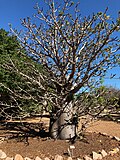Baobab
Baobab is the common name of a genus of trees (Adansonia). There are a total of eight types of its kind: six species live in the drier parts of Madagascar, two in mainland Africa, one in Australia and three in India. It is the national tree of Madagascar.
| Baobab | |
|---|---|

| |
| Adansonia digitata in Tanzania | |
| Scientific classification | |
| Unrecognized taxon (fix): | Bombacoideae |
| Genus: | Adansonia L.[1] |
Other names
Other common names include 'boab', 'boaboa', 'bottle tree', 'the tree of life', 'upside-down tree', and 'monkey bread tree'. The trees reach heights of 5 to 30 meters (16 to 98 ft) and trunk diameters of 7 to 11 meters (23 to 36 ft.). Its trunk can hold up to 120,000 liters of water. For most of the year, the tree is leafless, and looks very much like it has its roots sticking up in the air.
Medicinal uses
Baobabs are one of the largest and most important trees in all of where they grow, as they are able to provide shelter and wood. The leaves of the tree are used for making soup and the tree has some medicinal purposes in some regions of Africa[2] for treating ailments such as wounds, diarrhea, asthma, fever, and malaria.
Long life of baobab tree
The trees are long-lived, but just how long is disputed. The owners of Sunland Farm in Limpopo, South Africa have built a pub called "The Big Baobab Pub" inside the hollow trunk of the 22 metres (72 ft) high tree. The tree is 47 m (155 ft) in circumference, and is said to have been carbon dated at over 6,000 years old.[3]
Other uses
The baobab tree is known as the tree of life, with good reason. It can provide shelter, clothing, food, and water for the animal and human inhabitants of the African savannah regions. The cork-like bark and huge stem are fire resistant and are used for making cloth and rope. The leaves are used as condiments and medicines. The fruit, called "monkey bread", is edible, and full of vitamin C.[4][5] As of 2010 experts estimate the potential international market at a billion united states dollars a year.[6]
The fruit has a velvety shell and is about the size of a coconut, weighing about 1.44 kilograms (3.2 lb). It has a somewhat acidic flavour, described as 'somewhere between grapefruit, pear, and vanilla'.[6]
The tree can store hundreds of liters of water, which is an adaptation to the harsh drought conditions of its environment. The tree may be tapped in dry periods.[7]
Mature trees are usually hollow, providing living space for many animals and humans. Trees are even used as bars, barns, wine and beer shops and more.[8]
Baobab Media
References
- ↑ "Genus: Adansonia L." Germplasm Resources Information Network. United States Department of Agriculture. 12 November 2008. Archived from the original on 30 May 2010. Retrieved 14 January 2011.
- ↑ "TABLE 2 Medicinal Use of Baobab Fruits, Seeds, and Leaves Documented in..." ResearchGate. Retrieved 2020-08-08.
- ↑ Fancy a pint in the world's only bar that's INSIDE a tree?, Daily Mail, December 2007 Retrieved 27 August 2012
- ↑ "Scientists predict African fruit trees could help solve major public health problem". Bioversity International. Archived from the original on 2007-08-13. Retrieved 2008-10-01.
- ↑ Hills S. "Baobab goes for GRAS ahead of 2010 World Cup" FoodNavigator.com-USA, September 30, 2008
- ↑ 6.0 6.1 Lange, Karen E. (August 2010). Vitamin Tree. from magazine, also online. http://blogs.ngm.com/blog_central/2010/08/vitamin-tree.html. Retrieved 1 June 2012.
- ↑ "The Baobab tree in Senegal". Archived from the original on 2008-10-04. Retrieved 2008-10-01.
- ↑ Dance of the Boab.. National Library of Australia. 2 February 1966. p. 26. http://nla.gov.au/nla.news-article51187088. Retrieved 11 January 2012.










